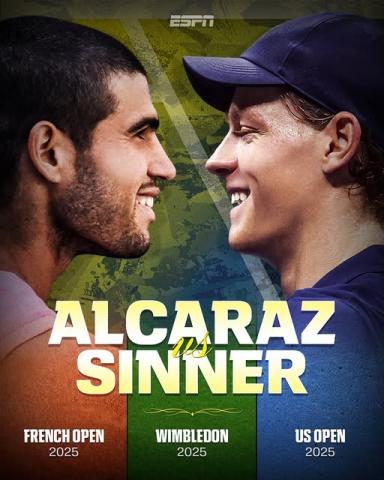
The 2025 tennis season will be remembered for one defining, unprecedented narrative: the total dominance of the rivalry between Carlos Alcaraz and Jannik Sinner. For the first time in the Open Era, the same two men have contested the final of all three major tournaments played this year—on clay, grass, and hard court.
The imagery is striking: Alcaraz and Sinner, locked in combat, with the trophies of Roland Garros, Wimbledon, and the US Open displayed between them. This isn't just a rivalry; it's a complete takeover of the sport, a duopoly of talent, power, and youth that has left the rest of the tour scrambling for answers.
A Trilogy of Finals: A Surface-by-Surface Analysis
Each final was a masterclass in adaptation, a chess match where each player's adjustments from the previous battle were met with new counter-strategies.
1. French Open (Clay): Alcaraz's Victory
-
The Battle: Clay, Alcaraz's natural habitat, demanded patience, heavy spin, and incredible physicality. Long, grueling rallies were the norm.
-
Alcaraz's Adjustments: Carlos used his devastating drop shot to perfection, exploiting Sinner's deeper court positioning. His topspin forehand kicked high to Sinner's backhand, and his defensive skills allowed him to stay in points until he could unleash a winner.
-
Sinner's Adjustments: Jannik focused on hitting flatter and deeper through the court, trying to shorten points and negate Alcaraz's superior mobility. His improvement in moving forward to handle drop shots was evident, though ultimately not enough on the slow Parisian clay.
-
The Outcome: Alcaraz's variety and clay-court prowess prevailed in a physical war of attrition.
2. Wimbledon (Grass): Sinner's Victory
-
The Battle: The slick grass of Wimbledon rewarded first-strike aggression, precise serving, and bold returning.
-
Sinner's Adjustments: Learning from Paris, Sinner took time away from Alcaraz at every opportunity. His serve was a weapon, generating free points. He stood on the baseline to return, taking the ball early and driving it with flat, penetrating power to keep Alcaraz on the back foot. He gave Carlos no rhythm.
-
Alcaraz's Adjustments: Alcaraz attempted to use his slice backhand more to stay low on the grass and serve-and-volley tactics to disrupt Sinner's returning rhythm. However, he was often forced into a passive position by Sinner's relentless pressure.
-
The Outcome: Sinner's cleaner, more powerful and direct game proved unbeatable on grass, a surface that amplified his biggest strengths.
3. US Open (Hard Court): The Decider
-
The Battle: The hard court is the great equalizer, offering a true test of who can best blend power, speed, and tactical intelligence.
-
The Evolution: This final was the culmination of their season-long dialogue. Sinner continued his aggressive returning and baseline dominance. Alcaraz, wise to this plan, focused on exceptional first-serve percentages and using his forehand to open the court early in the rally, preventing Sinner from unloading.
-
Key Adjustment - The Alcaraz Return Position: To counter Sinner's powerful serve, Alcaraz stood far back to return, much like he does against Nick Kyrgios, giving himself more time to react and use his big swing.
-
Key Adjustment - Sinner's Net Play: Knowing Alcaraz would use the drop shot, Sinner's forward movement and volleying were the sharpest they've ever been, turning a weakness into a strength.
-
The Outcome: A titanic clash that pushed both to their absolute limits, ultimately decided by a handful of points under extreme pressure.
What This Rivalry Tells Us
This historic trilogy of finals reveals the complete and evolving nature of both champions.
-
Sinner's Rise: He has transformed from a pure ball-striker into a tactically astute, mentally resilient, and complete player. His improvements in serve, net play, and physical conditioning are directly linked to the challenge Alcaraz presents.
-
Alcaraz's Depth: He is the more versatile and instinctively creative player. His ability to problem-solve and switch game plans across three different surfaces is a testament to a tennis IQ that belies his youth.
They are not just opponents; they are each other's greatest motivator and measuring stick. Their contrasting styles—Sinner's laser-guided power vs. Alcaraz's explosive variety—create a perfect spectacle.
The rest of the tour now faces a simple, daunting question: how does anyone break up this rivalry? For now, men's tennis is a two-man show, and we are all privileged witnesses to one of the greatest seasons and rivalries the sport has ever seen.
